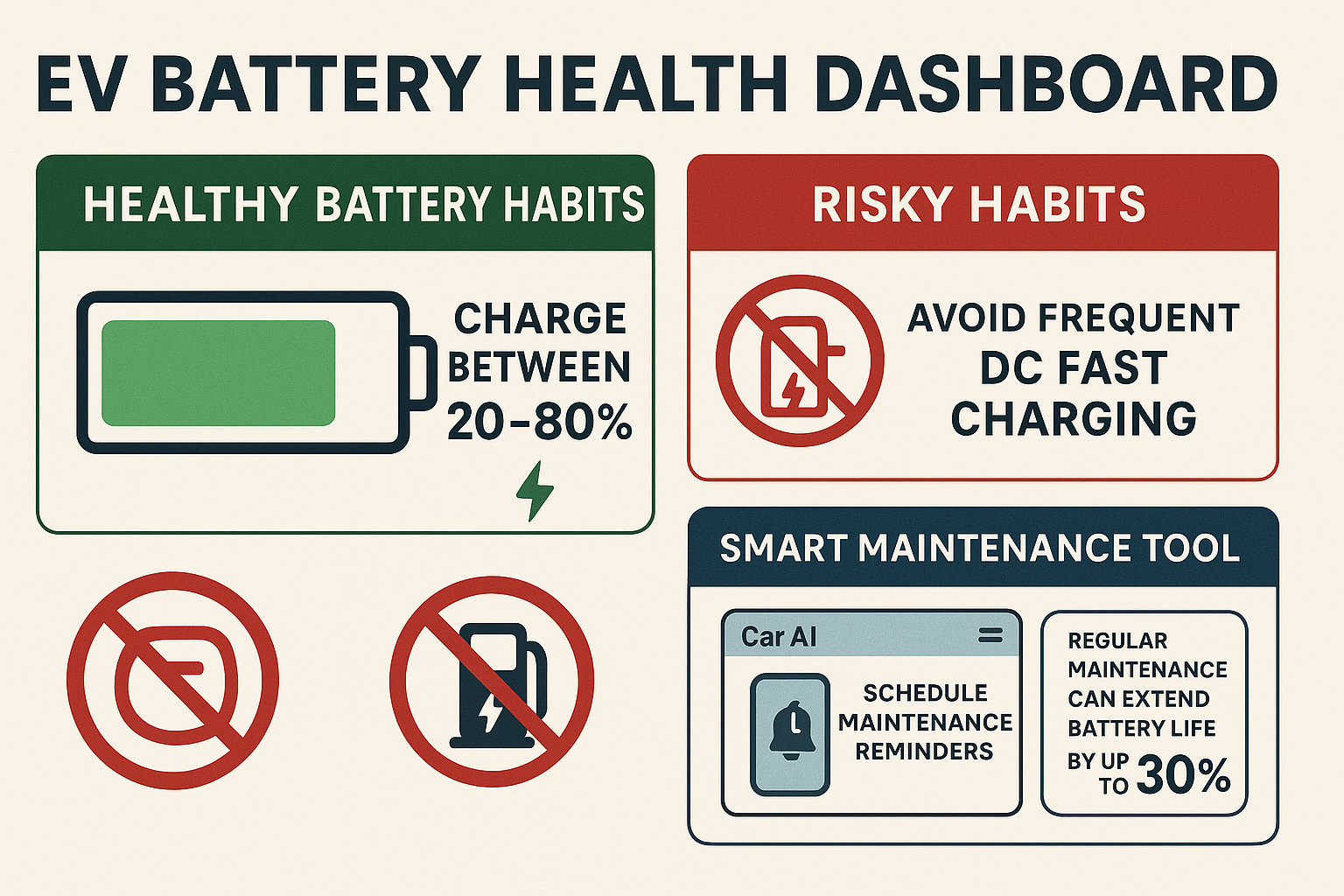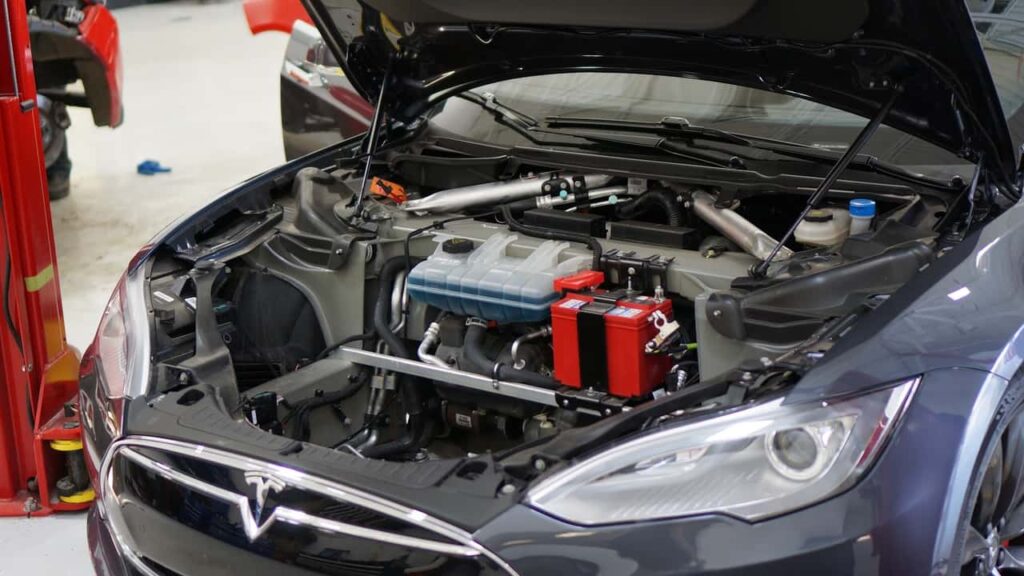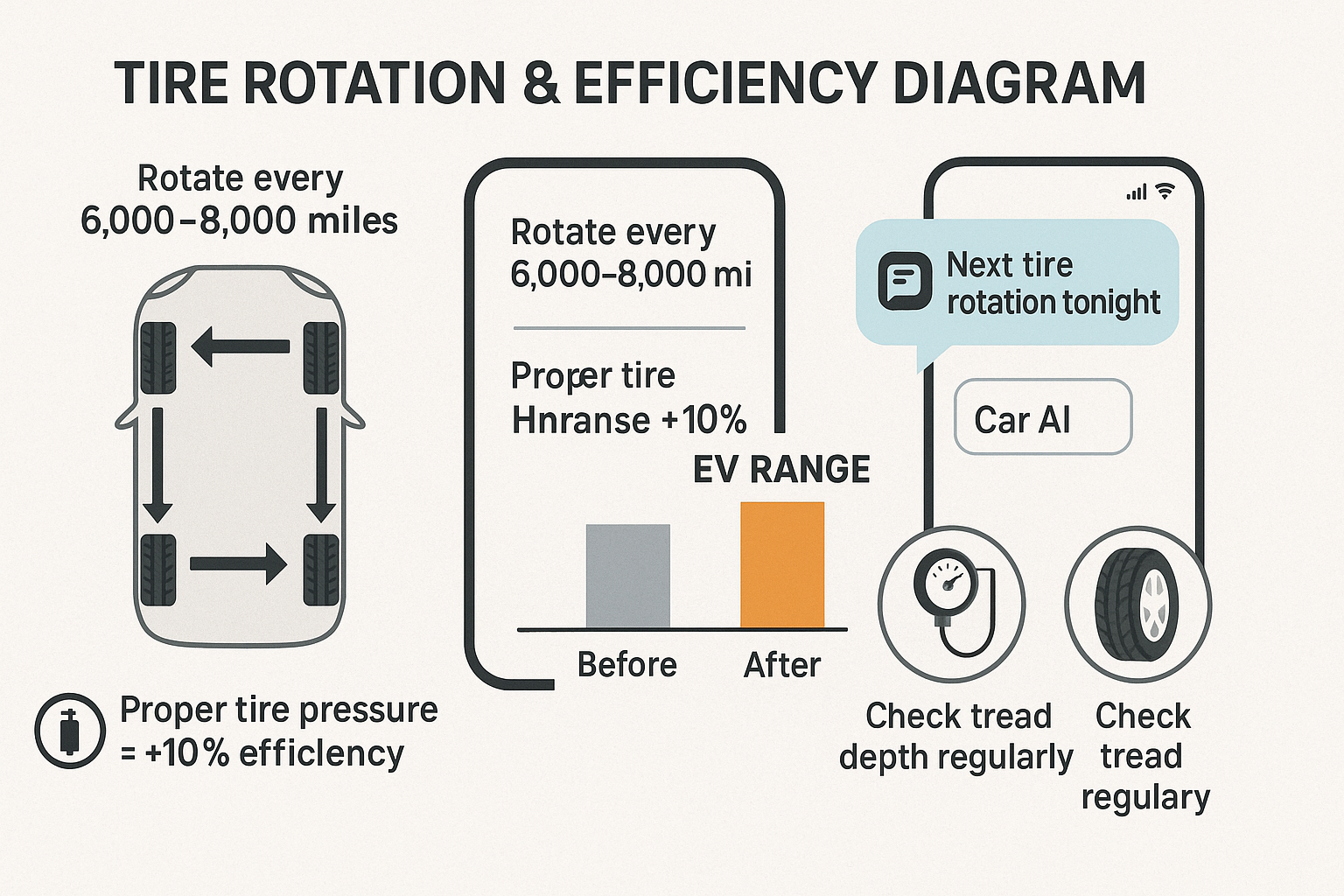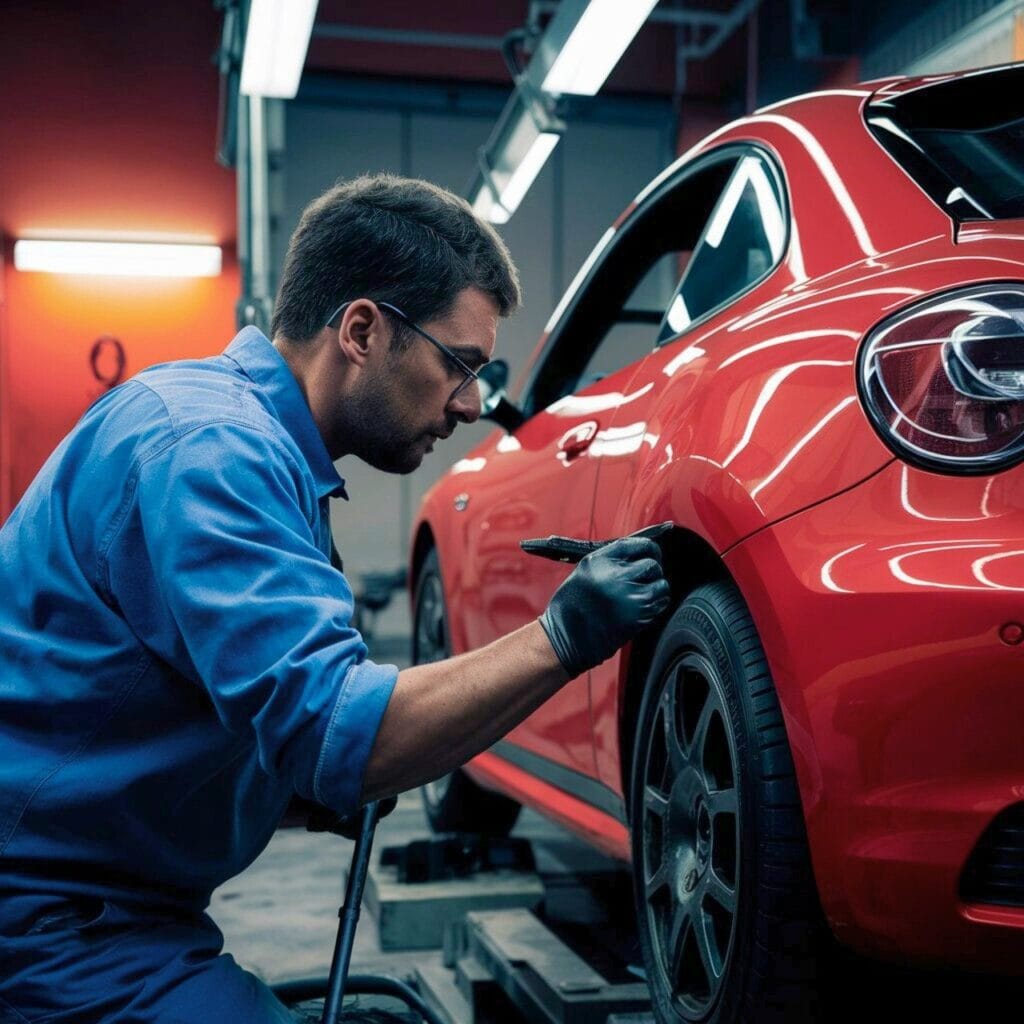Practical tips for eco-conscious drivers.
This guide covers Electric vehicle maintenance tips in detail to help you save money and extend your vehicle’s lifespan.

Here’s what you’ll learn…
- Effective battery health management strategies.
- Best practices for tire care and rotation.
- Essential brake system maintenance tips.
- Importance of software updates and diagnostics.
- How to inspect charging equipment and cabin air filters.
Battery Health Management
Frequency of Charging
When it comes to your electric vehicle (EV), the age-old question remains: how often should you charge? The answer can be as varied as the colors of a rainbow! Generally, it’s best to charge your EV regularly, ideally when it dips below 20% battery life. Think of it like keeping your phone charged; you wouldn’t let it die completely, right?
But here’s a little twist: frequent, shallow charging is actually better for your battery’s longevity than letting it drain down to the dregs. So, don’t be shy about plugging in!
Optimal Charging Practices
Now that you’re on board with the frequency, let’s talk about the how. Here are some optimal charging practices that can help you extend your EV battery life:
- Level 2 Charging: Whenever possible, use a Level 2 charger at home or work. It’s like giving your car a spa day—faster and more efficient!
- Avoid Fast Charging: While it’s tempting to use those quick-charging stations, they can stress your battery over time. Save them for emergencies, like when you’re running late for a dinner date.
- Charge to 80%: For daily use, aim to charge your battery to about 80%. This practice can significantly prolong battery health, as full charges can lead to wear and tear. Think of it as a gentle workout for your battery rather than a marathon!
- Temperature Matters: Keep an eye on the temperature. Batteries prefer a cozy range of about 20-25°C (68-77°F). If it’s too hot or too cold, it can impact charging efficiency and battery health.
- Use Smart Charging: If your EV supports it, take advantage of smart charging features that can optimize charging times based on electricity rates or your driving schedule. It’s like having a personal assistant for your battery!
Pro tip: If you have access to solar energy, consider charging your EV during the day when the sun is shining. It’s eco-friendly and can save you some bucks on your electricity bill!
For those who want to keep tabs on their battery health, our app offers Maintenance Reminders and insights into Vehicle Health & Costs. You can track your battery’s performance and get timely alerts, ensuring you’re always in the know about your EV’s condition.
Remember, electric vehicle electrical systems (battery, motor, and electronics) typically require minimal scheduled maintenance, and brake systems generally last longer than conventional vehicles[1]. All-electric vehicles have high-voltage electrical systems that meet rigorous safety and durability testing, ensuring protection against overcharge and other hazards[2]. So, while you’re busy keeping your battery healthy, you can enjoy the peace of mind that comes with owning an EV!
Tire Care and Rotation
Tire Pressure Monitoring
Keeping an eye on your tire pressure is crucial for electric vehicle (EV) owners. Did you know that properly inflated tires can improve your EV’s range? Under-inflated tires create more rolling resistance, which means your battery has to work harder. This can lead to reduced efficiency and a shorter driving range—definitely not what you want when you’re trying to get the most out of every charge!
Make it a habit to check your tire pressure monthly. Most EVs come equipped with a Tire Pressure Monitoring System (TPMS) that alerts you when your tires are low. However, don’t solely rely on it—manual checks can save you from unexpected surprises. Aim for the recommended pressure listed on the door jamb or in your owner’s manual.
Choosing the Right Tires
When it comes to tires, not all are created equal, especially for EVs. Look for tires specifically designed for electric vehicles, as they often feature lower rolling resistance and enhanced grip. These tires can help optimize your driving range and provide better handling. Brands like Michelin and Bridgestone offer excellent options tailored for EVs.
Pro tip: Rotate your tires every 5,000 to 7,500 miles to ensure even wear. This not only extends the life of your tires but also helps maintain optimal performance and safety.
Importance of Tire Rotation for Electric Vehicles
Tire rotation is especially important for EVs due to their weight distribution and the unique way they handle power. Electric vehicles often have a heavier front end because of the battery placement, which can lead to uneven tire wear. Regular rotation helps mitigate this issue and keeps your tires performing at their best.
Here’s what you should know about tire rotation:
- Frequency: Rotate your tires every 6,000 to 8,000 miles or as recommended by your vehicle’s manufacturer.
- Pattern: Follow the recommended rotation pattern—usually front-to-back or crisscross, depending on your tire type.
- Inspection: Use this time to inspect your tires for any signs of damage or wear. Catching issues early can save you from costly replacements down the line.
By following these tire care tips, you can enhance your EV’s performance and longevity while being eco-conscious. After all, a well-maintained tire not only keeps you safe but also helps you drive greener.
Brake System Maintenance
Understanding Regenerative Braking
If you’re cruising in an electric vehicle (EV), you might have heard of regenerative braking. It’s like magic! When you hit the brakes, instead of just wasting that energy as heat, your EV captures it and sends it back to the battery. This nifty feature not only helps extend your range but also reduces wear on your brake pads.
However, don’t get too comfortable! Just because your brakes are less stressed doesn’t mean they’re immune to wear. Regular maintenance is still crucial. Here’s the scoop:
- Check Your Brake Pads: Even with regenerative braking, your pads can wear down over time. Inspect them every 10,000 miles or so, or if you notice any unusual sounds when braking.
- Brake Fluid: Keep an eye on your brake fluid levels. It should be clear and at the recommended level. If it’s dark or low, it’s time for a change!
Signs of Brake Wear
So, how do you know if your brakes need a little TLC? Look out for these signs:
- Squeaking or Grinding Noises: If your brakes are singing a sad song, they might need replacing.
- Vibration: If your brake pedal vibrates when you press it, that’s a red flag! It could indicate uneven wear or warped rotors.
- Pulling: If your car pulls to one side when braking, it’s time to have your brake system checked.
Pro tip: Keep a maintenance log! Tracking your brake inspections and services can help you catch issues before they become costly repairs. It’s like having a personal mechanic right in your pocket!
Remember, while regenerative braking reduces wear, it doesn’t eliminate the need for regular brake maintenance. Stay proactive and keep your EV’s braking system in tip-top shape to ensure a safe and smooth ride!

Importance of Cooling Systems
Electric vehicles (EVs) may not have the same engine cooling needs as traditional cars, but don’t let that fool you! The cooling system in an EV is crucial for keeping the battery at optimal temperatures. A well-maintained cooling system ensures that your battery operates efficiently, prolonging its lifespan and performance.
Fluid Types and Maintenance
When it comes to fluids, the star of the show is the battery coolant. Here’s what you need to know about maintaining your EV’s cooling system:
- Regular Checks: EV battery coolant should be checked regularly for proper level and condition—look for color, clarity, and absence of debris. Also, inspect for leaks around the battery pack, following your manufacturer’s recommendations as procedures can vary[3].
- Annual Monitoring: It’s a good idea to monitor the coolant’s pH and conductivity annually. If the pH drops below 7.0 or if conductivity increases significantly, it’s time to change that coolant, regardless of mileage[4].
- Replacement Intervals: Replacement intervals can differ by manufacturer. For instance, Mercedes-Benz suggests checking or replacing coolant at 124,000 miles, while Hyundai and Kia recommend doing so at 80,000 miles. Interestingly, Tesla states that their coolant never needs to be changed[4].
Most EVs require minimal scheduled fluid maintenance, but those battery coolant checks are crucial for battery longevity and performance[4].
Pro tip: Keep a maintenance log of your coolant checks and changes. It’s like a diary for your EV—only much more exciting!
Software Updates and Diagnostics
Importance of Regular Updates
Keeping your electric vehicle (EV) up to date is like giving it a tune-up for the digital age. Software updates are crucial for enhancing performance, fixing bugs, and even unlocking new features. Think of it as your car getting a brain upgrade! Manufacturers often push out updates to improve battery management systems, enhance range, or even refine driver assistance technologies. So, don’t ignore those notifications—your car is basically saying, “Hey, I could be better!”
Most EV manufacturers recommend servicing every 10,000 to 15,000 miles or annually, whichever comes first, which is less frequent than gasoline vehicles due to simpler drivetrains and no oil changes[5]. This means you can spend less time in the shop and more time on the road.
Common Diagnostic Tools
When it comes to diagnostics, having the right tools can make all the difference. Here are a few common diagnostic tools that every EV owner should know about:
- OBD-II Scanners: These handy devices can read error codes from your vehicle’s computer, helping you diagnose issues before they become major headaches. Plus, many OBD-II scanners now come with smartphone connectivity, making it easier to keep tabs on your vehicle’s health.
- Battery Management Systems (BMS): Your EV’s BMS monitors battery performance and health. If you notice a drop in range, it might be time for a check-up.
- Tire Pressure Monitoring Systems (TPMS): Keeping an eye on tire pressure is crucial for safety and efficiency. Many EVs come equipped with TPMS, alerting you when tire pressure drops.
Regular diagnostics can save you from unexpected breakdowns and costly repairs. Electric vehicles typically require professional inspection every 20,000 kilometers (about 12,427 miles), with an annual check-up recommended; maintenance should be performed by certified mechanics trained in high-voltage safety[6].
Pro tip:
Always keep your owner’s manual handy! With the Owner’s manual access feature from Car AI, you can quickly find troubleshooting tips and maintenance schedules right at your fingertips. It’s like having a mechanic in your pocket!
By leveraging these tools and staying on top of software updates, you can ensure that your EV runs smoothly and efficiently. Plus, with Car AI’s AI car assistant, you can get personalized answers and tips, making maintenance feel less like a chore and more like a fun project. Now, that’s what we call a win-win!
Charging Equipment Inspection
Keeping your EV’s charging equipment in tip-top shape is crucial for a smooth ride. Regularly inspect your charging cables and connectors for any signs of wear or damage. Look for frayed wires, bent prongs, or any corrosion that might sneak in. A good rule of thumb is to clean the connectors with a soft cloth and a little isopropyl alcohol to keep them shiny and functional.
- Check for proper alignment: Ensure your charging plug fits snugly into the port. A loose connection can lead to inefficient charging.
- Look for moisture: If you notice any moisture around the charging port, it’s best to avoid charging until it’s completely dry to prevent electrical issues.
Cabin Air Filters
Did you know that cabin air filters play a vital role in your EV’s comfort and air quality? These filters trap dust, pollen, and other pollutants, ensuring that the air you breathe inside your car is fresh and clean. Over time, they can get clogged, which can affect your HVAC system’s performance.
- Replace regularly: Check your owner’s manual for the recommended replacement interval. Generally, it’s wise to change your cabin air filter every 15,000 to 30,000 miles.
- Consider your environment: If you live in a dusty area or frequently drive in heavy traffic, you might want to replace it more often.
Pro tip: Keep a spare cabin air filter in your trunk! It’s a quick swap that can save you a trip to the shop.
To maximize the lifespan and performance of your electric vehicle, follow a regular service schedule—rotating tires, checking fluids, inspecting brakes, replacing cabin air filters, and periodically evaluating battery health—while always consulting the owner’s manual for model-specific guidance[7].
Conclusion
In summary, choosing the right Electric vehicle maintenance tips can save you time and money.
Reflective Summary
Electric vehicles are more than a trend—they’re a daily choice that saves fuel, cuts emissions, and changes how we think about car care. For EV owners and eco-conscious drivers, knowing how to extend battery life, cut operating costs, and keep systems healthy isn’t optional; it’s smart stewardship. This guide pulled together practical, tech-forward tips (backed by standards and best practices you’d expect from IIHS, API references, and regional testing like SIRIM) so you can make confident decisions—no jargon, just useful moves.
Practical Next Steps
- Check battery health and software updates monthly; a well-timed OTA update can prevent costly issues.
- Use smart charging habits: avoid consistent 100% charges and aim for mid-range daily SOCs for longevity.
- Track service, receipts, and kWh in one place so you spot trends—tire wear or inefficient HVAC show up in the logs.
- Schedule temperature management and preconditioning where available to reduce battery strain.
That’s exactly why Car AI’s reminders and personalized insights exist—Try Car AI free (getcarai.com) and watch the demo video to see the assistant set smart, localized maintenance reminders in seconds.
Car AI combines owner’s manual access, dynamic health scores, and recall alerts so you can be proactive, not reactive.
Think of it like giving your EV a little routine TLC—your wallet, range anxiety, and the planet will thank you. What’s the one maintenance task you always forget?
References
Don’t miss out on seamless car maintenance. Try our app today!
Footnotes
- https://afdc.energy.gov/vehicles/electric-maintenance
- https://afdc.energy.gov/vehicles/electric-maintenance
- https://fleetrabbit.com/blogs/post/hybrid-and-ev-maintenance-battery-coolant-guide
- https://fleetrabbit.com/blogs/post/ev-fluid-maintenance-coolant-and-brake-systems
- https://www.bmwofkansascitysouth.com/blog/2023/december/12/when-to-service-your-bmw-ev.htm
- https://www.renaultgroup.com/en/magazine/energy-and-motorization/all-there-is-to-know-about-electric-car-maintenance/
- https://www.carifex.com/blogs/news/do-electric-cars-need-maintenance


